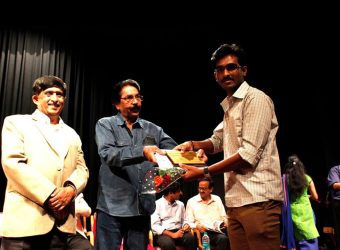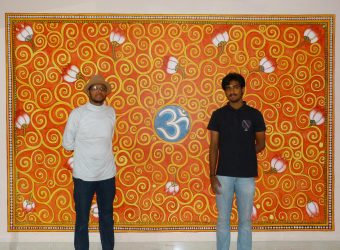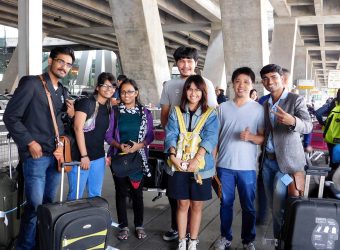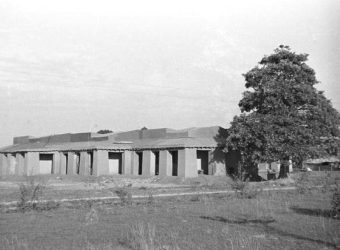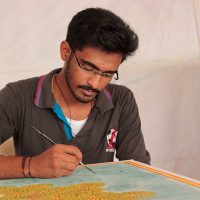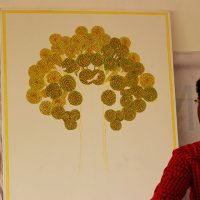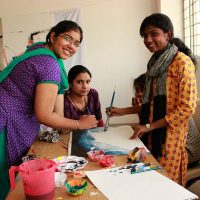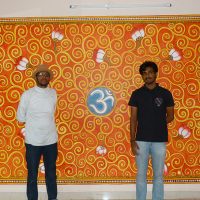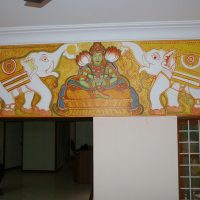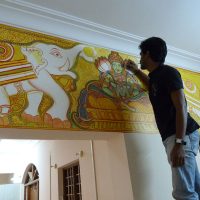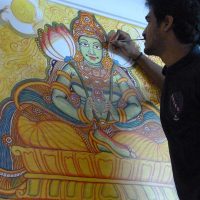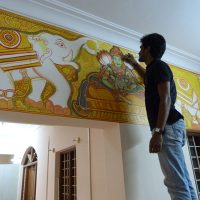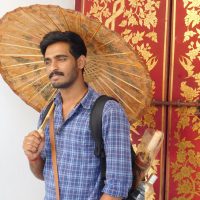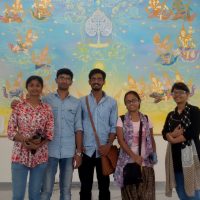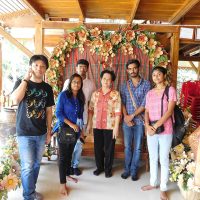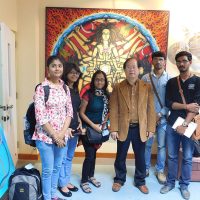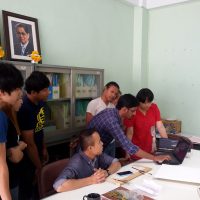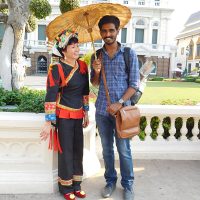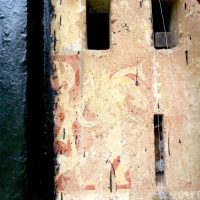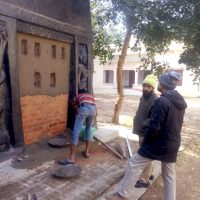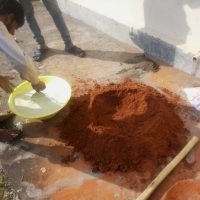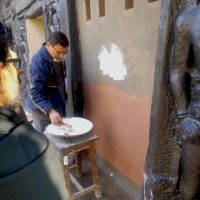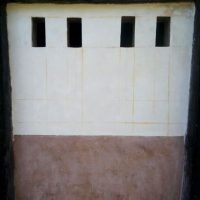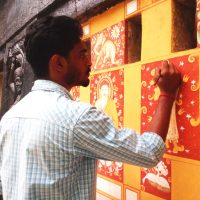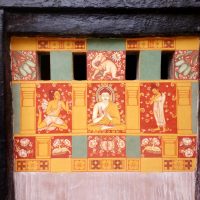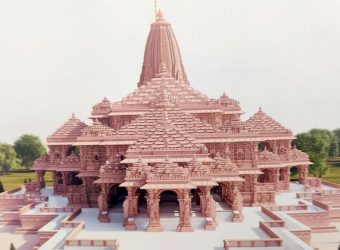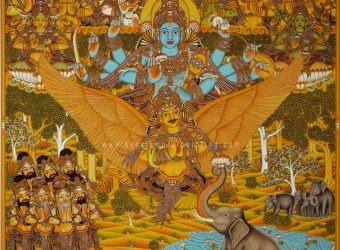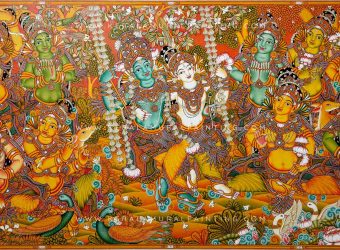Home
I'm a Mural Artist
from Kerala, India
Teacher
I specialize in traditional Kerala Mural paintings and Indian mural paintings. My works mainly dipict Lord Ganapathi, Lord Krishna, and Perumthachan; a legendary carpenter and an expert architect.
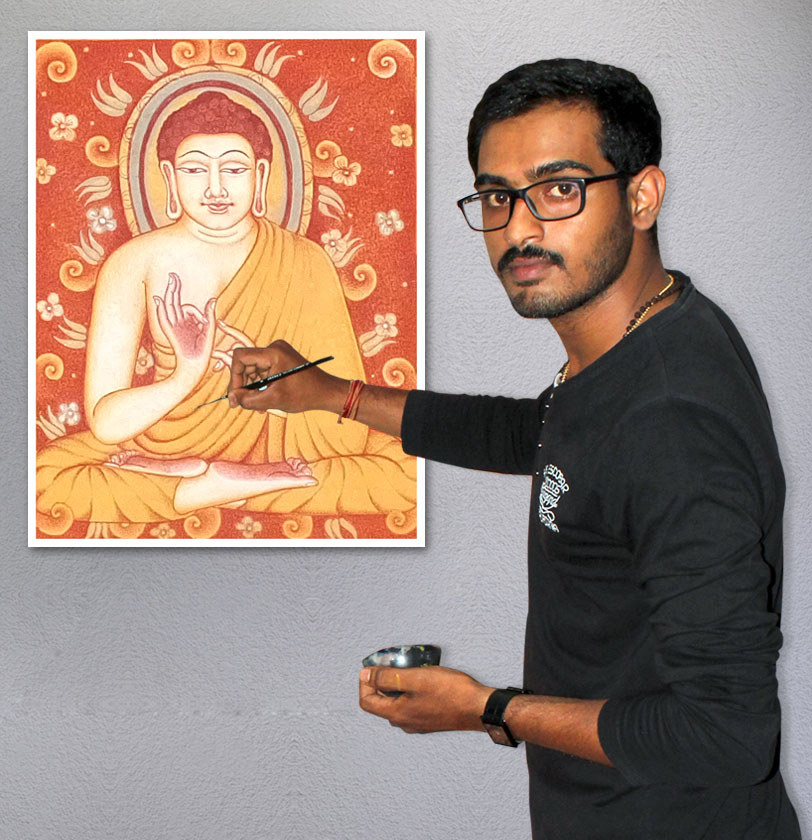
I'm a Mural Artist
from Kerala, India
Teacher
I specialize in traditional Kerala Mural paintings and Indian mural paintings. My works mainly dipict Lord Ganapathi, Lord Krishna, and Perumthachan; a legendary carpenter and an expert architect.
In persuit to promote Kerala Mural Paintings and it's techniques.
Mural Paintings on Demand
A Mural painting can retain the traditional values, depict your culture and can be the center of attration.
Camps and Training Sessions
I have been conducting camps inside and outside India and I also give training for those who have love and interest in mural painting.
Repair and Restoration
Paintings can decay partially or completely due to aging. Such paintings can be restored using scientific methods.

Vishnu P. Vikraman
I am deeply immersed in the world of Kerala mural and Indian traditional mural painting techniques. My journey began at Sree Sankaracharya University of Sanskrit, where I pursued a BFA in Kerala mural painting, delving into the intricacies of this exquisite art form. Building upon this foundation, I furthered my studies at Visva Bharati University in Santiniketan, West Bengal, where I earned an MFA specializing in Indian traditional mural techniques. During my time at Visva Bharati, I participated in a student exchange program with Burapha University in Thailand, where I explored Laran Thai mural painting. This unique experience broadened my perspective and enriched my understanding of different mural painting traditions.
Portfolio
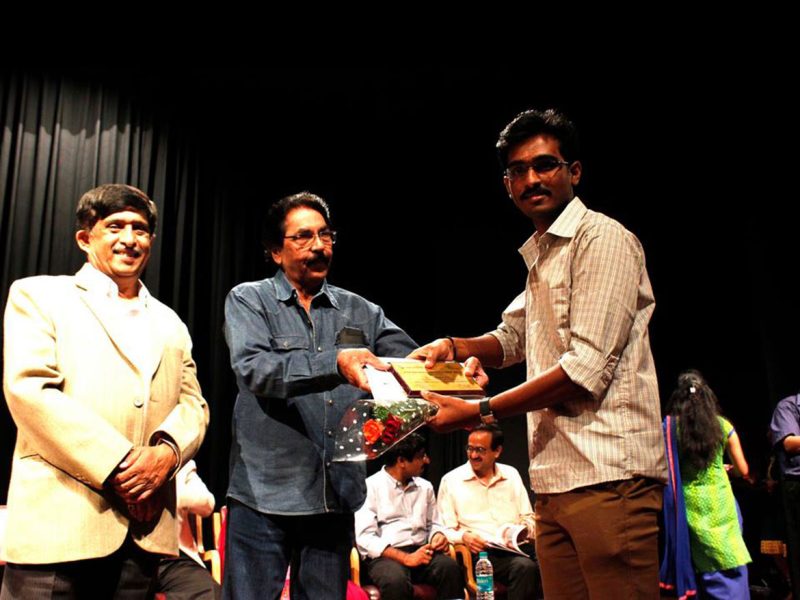
During 2014, I had the opportunity to attend this camp at Bangalore, where a selected twenty famous and upcoming artist camp from different states of India. The camp was inaugurated by famous contemporary artist Yusuf Arakkal. I make a 4’ x 5’ Nature alive panting for CMRIT artist exhibition. Medium I used was acrylic on canvas. The theme of the subject was a central tree motif that holds a host of birds and other creatures, symbolizing the abundance and fretfulness of nature.
Artist who attended the Camp were – Shivi Sharma, Girish B Kulkarni, Gurusiddappa GE, Anamika V, Appanna Pujari, Jayakumar G, Nilanjana Nandy, Srinivasa Reddy, Mhesh Baliga, Sujata Sah Sejekan, Sumana Som, Gubenddhiran K, Thirumala Thirupati, Kirti Chandak, Ajay Kothavale, Vishnu P.V, Thejendra Sing Baoni, JMS Mani, Prasanna Kumar and Atanu Mukherjee.
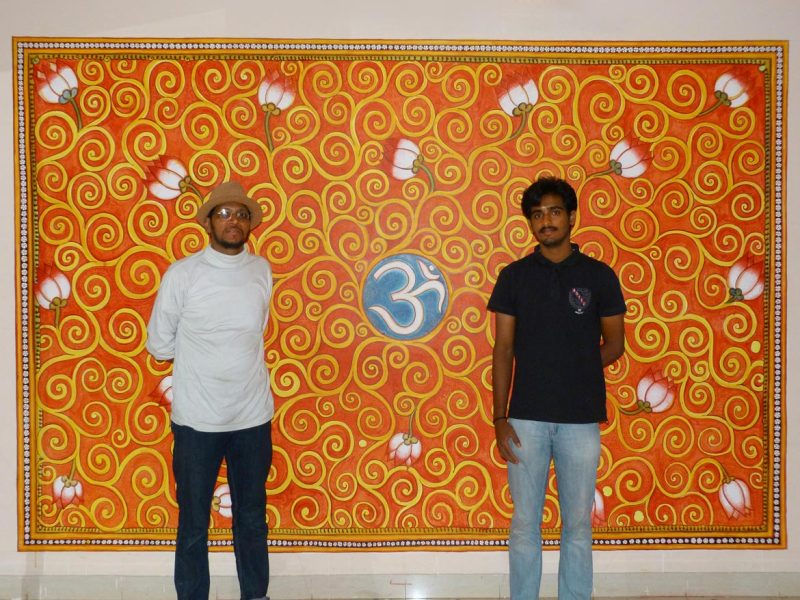
Wall Mural
Starting of 2014 I had assisted one of my Guru Sri Suresh K Nair, (Assit Prof Banaras Hindu University, Painting dept) for Aurveda Hospital In Bangalour. We together completed two paintings for the hospital. One at the entrance and the other was at the visitors room of the hospital. The subject of the painting was selected by Suresh K Nair. The painting – Gajalakshmi was for entrance and for the visitors room he selected a Meditation Symbolic painting (which is his creative style) which took 4 days of hard work.
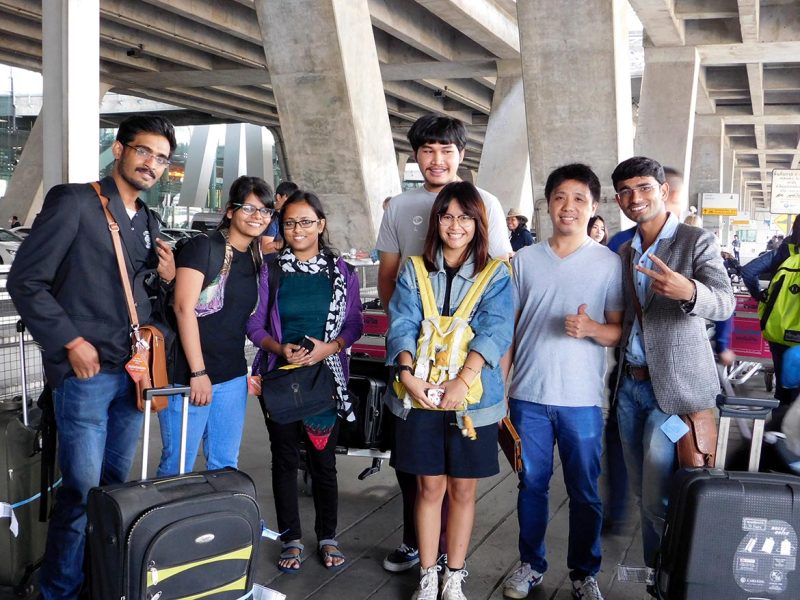
Thailand Visit
Five students including me had been sent to Burapha University for the detailed study of paintings and sculptures. We take this opportunity to thank the teachers and students of Bhurapha University for their kind cooperation and consideration.
Palazhimadhanam installation and other paintings and sculptures made of gold which we observed at the Suvarnabhoomi Airport was my first step to a new artistic world. The significance of gold in the art and cultural field of a Buddhist country like Thailand is immense. They largely use gold in most of the sculptures and paintings including mural paintings.
For the study purpose we visited several Buddhist temples . The most attractive and beautiful among them was the gold decorated murals and sculptures of Wat phra kaew temple in Bangkok . Most of the mural paintings are based on Ramayanam stories. We saw very minute and detailed work in each and every painting. Much similarity could be seen between Indian miniature painting and Thailand mural painting.
In Thailand, they use natural colours for mural paintings. They prepare walls by giving a coat of the mixture of jaggery, lime and other mixtures from nature. The most attractive feature is the fixing of gold on the ornaments of their paintings.
We copied the traditions of Thai mural paintings which we feel most attractive to our books and then to canvas.
The sanctuary of truth in Pattaya which is fully made up of Teakwood was the most beautiful and exciting building in Thailand. The sculptures in this building are based on the three god concepts of Hindus and the concepts of Buddhism. The minute and exciting work of this building had started since 1980 and expecting to be completed by 2050.
The colourful paintings, the beautiful sculptures and other handicrafts of Thailand are ever memorable. The training given by the teachers and the hospitality of our friends in Thailand are the most valuable gifts that ever had in our life and we will remain in our memory for ever.
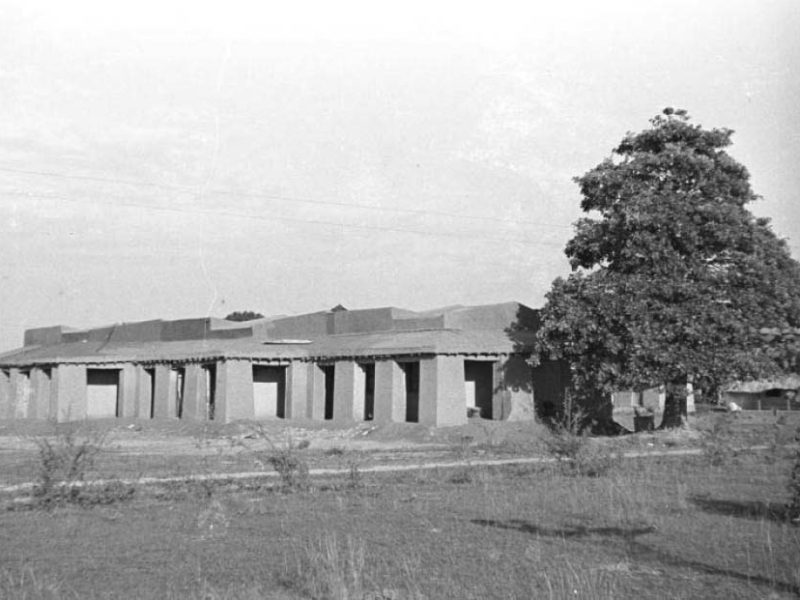
Black House
Supervised and built by Ramikinkar Baij, Nandalal Bose and additionally worked on by Prabhas Sen, Sukhomoy Mitra among other students along with students in 1938, may be considered an experiment firmly placed within the experimental ethos of those teaching at Kala Bhavan at the time. The Black House was made from mud, painted black and its walls covered with a variety of motifs, local and international, in low relief.
Kala Bhavan, the parent institution was founded on the integration of art and craft. A year before the making of ther black house Shyamali, the mud house was built in the housing complex of Tagore . Nandalal and Ramkinker , especially Ramkinker had a hand in that . So in 1936 when Black house came up they already had some experience in making mud dwellings.
Under the aegis of Visva Bharti university I received the sanction to do wall painting in the historically Iconic, mud building ‘black house’ build by recreating the famous sculptures of India others of world renown. The work was carried out after removing completely the damaged wall painting.
The walls were constructed in Jaipur style using quick lime, marble dust, and jaggery mixture which was incorporated with (milk protein) casein tempera that makes use of cheese, quick lime and natural colours. This momentous art work is based on many cave paintings of Ajanta in Maharashtra.
This work was completed with the support and guidance of my teachers Sri Nandu dhulal Mukherji and Dhilip Mithra of the Mural Department Visva Bharati University, (kala bhavan). These paintings are done in such a way that they will not be damaged by exposure to Rain and Sun.
See what my friend Shubhashis had to say about this project.
My Paintings
Hindu epics and deities had always captured my attention and this is very much evident in my paintings.
Many of my paintings could fall in the following four categories.
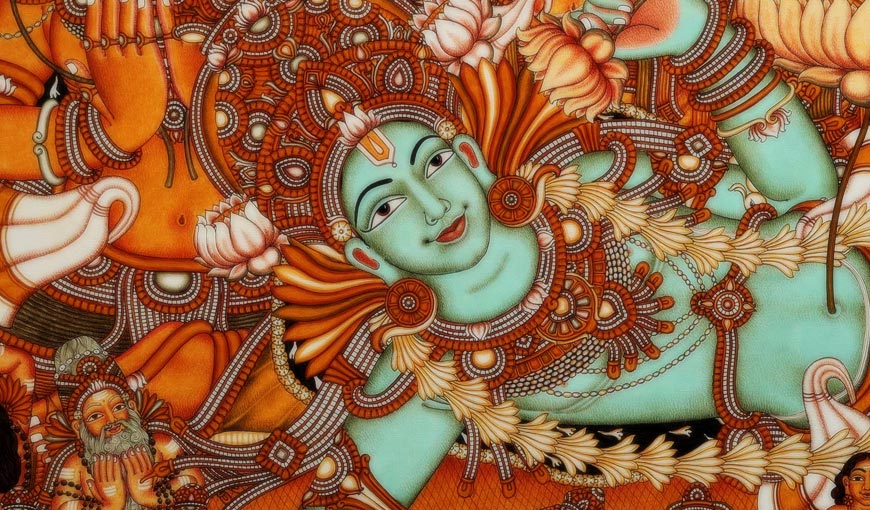
Kerala Mural Painting
Searching for the roots of murals in Kerala takes us back in to the 7th, 8th centuries. They function as a sort of ‘dynamic theater stills’, elucidating characters and episodes, preserving a whole lot of traditions always in communion with the past, as brilliant picturesque reminder of our ethos.
Anatomy of characters, including animals trees etc, are represented in a regionally stylized form. One panel might hold several scenes Separated by specific lines (manimala). Yellow, red, green, white and black are the most prominent hues seen in the murals of Kerala.

Ganapathi Series
The figure of Lord Ganesha, Son of Lord Shiva and Devi Parvati Ganesha is popularly worshipped under the names of Sumukha, Ekadanta, Kapila, Gajakarna, Lambodara, Vikath, Vidhnanashaka, Vinayaka, Dhumraketu, Ganadhayaksha, Bhalchandra and Gajanana.
The large elephant head of Lord Ganesha symbolizes wisdom, understanding, and a discriminating intellect that one must possess to attain perfection in life.
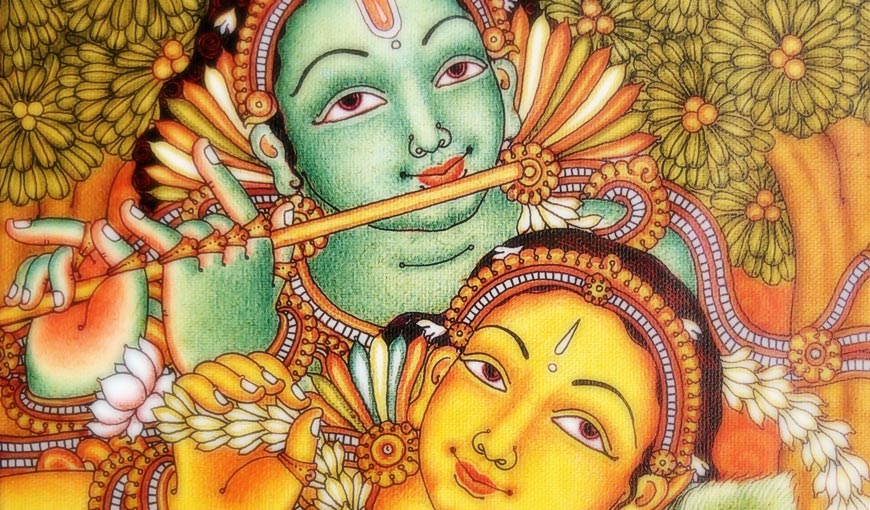
Krishna Series
Krishna is a name of the original, unique Supreme Person, the source of all that exists. Krishna appears as other forms of God avatars to create and maintain the universe, while He simultaneously enjoys loving relationships with His countless associates in the spiritual world. He visits this material world from time to time to free his devotees from material existence and to vanquish the wicked. He performs superhuman pastimes lifting mountains, swallowing forest fires, and killing numerous extraordinarily powerful demons as easily as a child playing with toys.
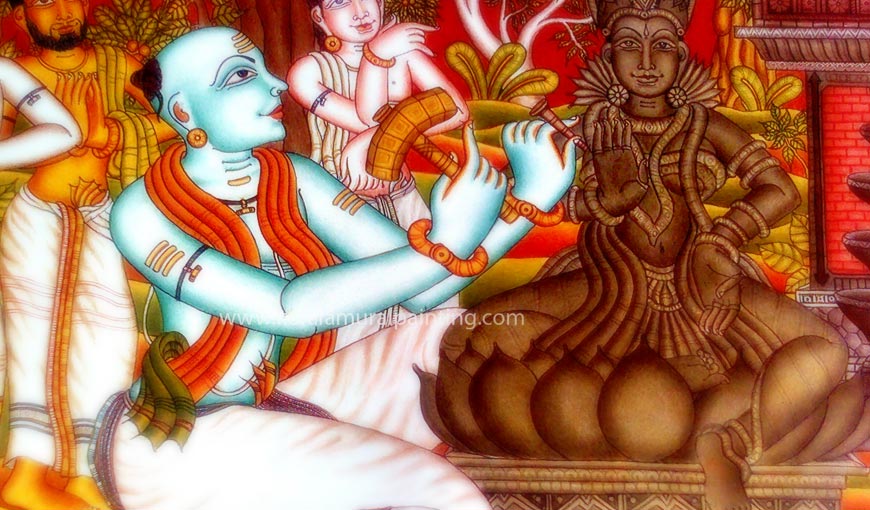
Perumthachan Series
In the ancient history of Kerala, the building construction and designing also in sculptures the famous Perumthachan’s donations are great and still it is prominently visible in some of the olden temples. The new version of Perumthachan painting series which is in the form of wall paintings was done on the basis of novel named “agnihothram” written by KB Sreedevi, a well known Kerala writer.
The main theme of the Perumthachan series in the wall paintings is the murder of his own son by dropping the chisel and pretending it as if it is an accident. It happened because of Perumthachan’s ego which developed due to jealousy on his son who was becoming famous in his architectural & sculptural works.
Latest Updates
Ayodhya Ram Temple Kumbabishekham
Ayodhya Ram Temple Kumbabhishekam is supposed to take place at Ayodhya on 22 nd January 2024. On account of this, now itself grand celebration takes place in this temple to gratify our great Lord
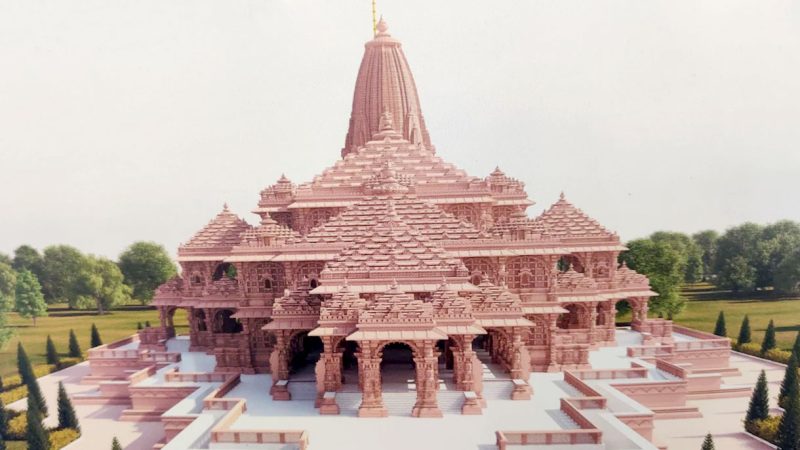
Ayodhya Ram Temple Kumbabishekham
Ayodhya Ram Temple Kumbabhishekam is supposed to take place at Ayodhya on 22 nd January 2024. On account of this, now itself grand celebration takes place in this temple to gratify our great Lord Ram. Ram Janmabhoomi is the Holy place, which is believed to be the birth place of Lord Rama, an avatar of Lord Vishnu. As per the great epic Ramayana, Rama's birthplace is located on the banks of the Holy Sarayu River in the city of Ayodhya.The construction of the temple is mostly completed, though yet, some amount of construction work is pending as of now, with the consecration ceremony expected to take place on January 22, 2024. Prime Minister Narendra Modi is expected to attend this mega divine ceremony, and the temple trust plans to invite few thousands of people, which includes, holy people like saints and pontiffs, to the ceremony. The Sri Ram Janmabhoomi Teerth Kshetra Trust cordially invite out honorable PM Modi for the consecration ceremony during which the idol of Ram Bhagavan will be installed in the sanctum sanctorum of the temple.
The Ram temple in Ayodhya is supposedly kept open for the devotees after the consecration of Ram idol. Construction of Rama Temple at his birth place is a good task, since by doing that, the Ram devotees, wishes are getting fulfilled and they can get the darshan of their beloved god Rama. The Ram Temple interior would be cleaned, and the wonderful event could also be seen through social medias. On January 22nd Ayodhya Ram Temple Kumbabhishekhem program is expected to take place between 12 noon to 2.30 pm in the temple where in which, all of the devotees would be having the facility to joyfully watch it through video.
Darshana details:
After the consecration, the temple will be kept open for devotees to perform & quot ;aarti& quot;. The sacred idol of Lord Ram will be seated in the temple on 22 nd January 2024, between 12:15 pm to 12:45 pm, which coincides with the Mrigasira Nakshatra. Eminent and efficient Vedic scholars of Kashi will perform the consecration ceremony. Bhagavan Ram Aarti is scheduled three times a day. Devotees can participate in the aarti at 6:30 am, 12:00 noon, and 7:30 pm, and a valid pass made by the Trust is required and we must provide an ID proof also! Mobiles and outside food are not allowed inside the temple. Those attending the ceremony on January 22 need to rush to the venue before 11.00 am itself, and there is no strict dress code imposed by the Ayodhya Ram Temple Trust. The temple complex provides lot of facilities, for the benefit of the disabled and elderly, and nearly about 25,000 visitors could be able to accommodate inside the temple, to watch the magnificent glorious grand consecration ceremony event!
The Idols of temple
The entrance has 32 stairs through the Singh Gate, leading to the sanctum sanctorum where Ram darshan can be seen from a distance of 30 feet. The statue will be placed along his three brothers in the sanctum sanctorum of the grand temple.
Apart from the main shrine of Lord Rama, the temple contains few more deities such as Lord Surya, Goddess Bhagwati, Lord Ganesha, Lord Shankar, Mata Annapurna, Pawan Putra Hanuman, Mata Shabari, Maharishi Vishwamitra, Maharishi August, Maharishi Valmiki, and Nishad Raj are there for devotees.
Lord Sree Rama
Sri Rama is the major Idol of Ayodhya Rama temple. He is the most and seventh popular Avatar of Vishnu. The lord Rama was born in Ayodhya the capital Kingdom of Kosala and the elder son of Kausalya and Dasharatha. Lakshmana, Bharata, and Shatrughna are his brothers. Sita was his wife. Lord Rama is the one of the major deity of Hinduism.
Kumbabhishekam
Kumbabhishekam also known as Consecration ceremony, is a famous ritual held in the temples, once in 12 years, in order to add more spiritual powers to the deities present in the temple and it is also performed in order to honour, and to pay our great respects to the almighty. During the time of Kumbabhishekam, Holy Water would be fetched from the sacred rivers, and the deities present inside the temple, as well as the Gopura Kalasam would be bathed with the Holy water, since it is believed that the powers of the deities present even at the top of the Temple Gopuram. Apart from the temples of the deities, Kumbabhishekam is also performed in the temples of Sri Shridi Sai Baba, and Guru Raghavendra Swamy.
During the time of Kumbabhishekam, various divine mantras would be chanted, in order to please the deities. After the performance of Kumbabhishekam, temple Prasad would be distributed and free food also would be offered to all the devotees in a pleasing manner. This sacred ceremony would be performed on an auspicious day, and during that time all the devotees would be invited by circulating notices, in order to be present and attend the holy event on the day of Kumbabhishekam. This ceremony is being performed in order to give a new life to the deities present in the temples. Kumbhabhishekham is grandly celebrated as an important festival in India, and after the performance of Kumbhabishekham, the deities would get more powers, and they would shower their divine blessings on all the devotees.
Mural Painting of Gajendra Moksham: A Divine Narrative on Canvas
Introduction: Mural painting is an ancient form of art that has been used throughout history to depict stories, convey messages, and showcase cultural and religious narratives. One such compelling mural painting that captivates the
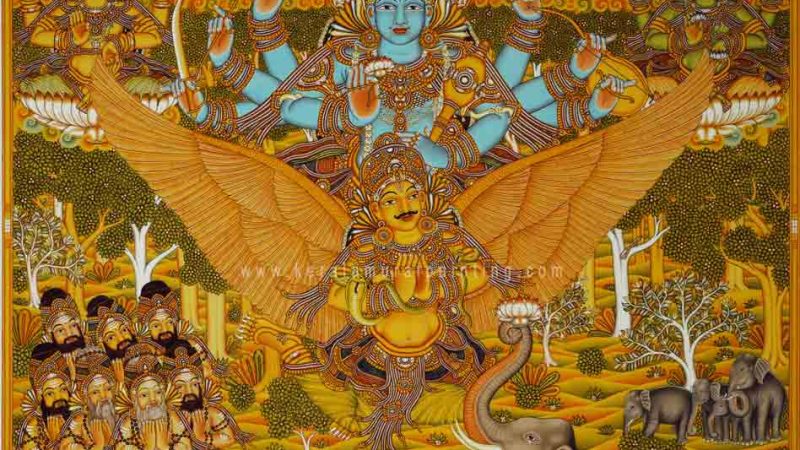
Mural Painting of Gajendra Moksham: A Divine Narrative on Canvas
Introduction:
Mural painting is an ancient form of art that has been used throughout history to depict stories, convey messages, and showcase cultural and religious narratives. One such compelling mural painting that captivates the essence of Hindu mythology is the portrayal of Gajendra Moksham. This intricate and divine artwork brings to life the legendary tale of Gajendra, the elephant king, and his liberation (moksha) from the clutches of a formidable crocodile.
Legend of Gajendra Moksham:
The story of Gajendra Moksham is derived from the Bhagavata Purana, an ancient Hindu scripture. According to the legend, Gajendra, the king of elephants, was once enjoying a leisurely bath in a serene lake. Unbeknownst to him, a powerful crocodile named Huhu emerged from the depths and clamped its jaws around Gajendra’s leg. Despite the elephant’s valiant efforts, he found himself trapped and in great distress.
As Gajendra realized the futility of his strength, he turned his thoughts towards the divine. In a heartfelt prayer, he called out to Lord Vishnu for help. In response to Gajendra’s sincere plea, Lord Vishnu, mounted on his eagle-shaped vehicle Garuda, swiftly arrived at the scene to rescue the distressed elephant. The divine intervention led to the liberation of Gajendra from the clutches of the crocodile, symbolizing the victory of devotion and the grace of the Supreme.
Mural Painting Representation:
The mural painting of Gajendra Moksham captures the emotional and spiritual nuances of the narrative with meticulous detail and vibrant colors. Here are key elements depicted in the mural:
- Composition and Layout:
- The mural is likely to feature a harmonious composition, with Gajendra at the center, surrounded by the serene lake, lush vegetation, and divine beings.
- Expression and Emotion:
- The facial expressions of Gajendra, the crocodile, and Lord Vishnu are crucial in conveying the emotional depth of the story. Gajendra’s agony, Vishnu’s compassion, and the fierce determination of the crocodile are expressed through subtle yet impactful details.
- Divine Intervention:
- The mural emphasizes the divine intervention of Lord Vishnu, often depicted with four arms, holding his iconic conch, discus, mace, and lotus. Garuda, the celestial eagle, may be shown accompanying Vishnu.
- Symbolism and Allegory:
- Various symbolic elements, such as the lotus (associated with purity and enlightenment), the conch (symbolizing the cosmic sound), and the crocodile (representing the cycle of birth and death), contribute to the allegorical richness of the mural.
- Color Palette:
- A vibrant and rich color palette is employed to evoke the divine and mystical atmosphere. Blues and greens for the water and foliage, gold for the divine figures, and earthy tones for the elephant and other elements create a visually engaging composition.
Conclusion:
The mural painting of Gajendra Moksham serves as a visual ode to the timeless narrative of devotion, divine intervention, and liberation found in Hindu mythology. Through meticulous artistry and storytelling, this mural becomes a timeless expression of faith, inviting viewers to immerse themselves in the profound spiritual journey of Gajendra and the transcendent power of Lord Vishnu.
Traditional Mural Painting of Kerala
Introduction Kerala, a state situated in the southwestern part of India, is not only known for its lush landscapes and backwaters but also for its rich cultural heritage. One of the vibrant facets of
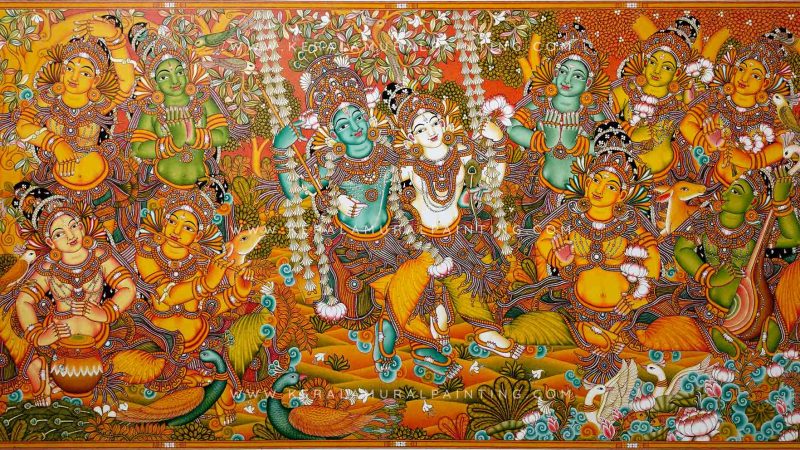
Traditional Mural Painting of Kerala
Introduction
Kerala, a state situated in the southwestern part of India, is not only known for its lush landscapes and backwaters but also for its rich cultural heritage. One of the vibrant facets of Kerala’s cultural tapestry is its traditional mural paintings. These paintings, deeply rooted in history, are characterized by intricate designs, vibrant colors, and themes that often depict mythological stories and religious motifs.
Historical Background
The tradition of mural painting in Kerala dates back to ancient times, with evidence suggesting that it flourished during the rule of the Chera dynasty (c. 300 BCE – 1102 CE). The art form gained prominence in temples, palaces, and churches, becoming an integral part of Kerala’s architectural and cultural identity.
Characteristics of Kerala Mural Painting
1. Technique:
- Fresco Technique: Traditional mural paintings in Kerala are executed using the fresco technique, where pigments are applied on wet plaster. This ensures the longevity of the artwork as the colors seep into the plaster, creating a lasting bond.
2. Color Palette:
- Vibrant Colors: Kerala mural paintings are renowned for their vibrant color palette, comprising a range of natural pigments. The artists use a variety of mineral and vegetable colors, derived from stones, minerals, leaves, and flowers.
3. Themes and Subjects:
- Mythological Narratives: Many of the mural paintings in Kerala depict scenes from Hindu mythology. The walls of temples often feature episodes from the epics Ramayana and Mahabharata, as well as stories of various gods and goddesses.
- Religious Motifs: Mural paintings are not limited to Hindu temples; Christian churches in Kerala also boast intricate mural art with themes from the Bible.
4. Symbolism:
- Symbolic Elements: Artists incorporate symbolic elements into their works, conveying deeper meanings related to spirituality and cultural values. Animals, plants, and geometric patterns often carry symbolic significance.
5. Style and Form:
- Linear Grace: Kerala mural paintings are characterized by linear grace and stylized forms. The artists skillfully blend form and rhythm to create visually captivating compositions.
Notable Examples
1. Padmanabhapuram Palace:
 The Padmanabhapuram Palace, located in the Kanyakumari district (Tamil Nadu), was the ancient capital of the Travancore kingdom. The palace features exquisite mural paintings, depicting scenes from Hindu mythology.
The Padmanabhapuram Palace, located in the Kanyakumari district (Tamil Nadu), was the ancient capital of the Travancore kingdom. The palace features exquisite mural paintings, depicting scenes from Hindu mythology.
2. Mattancherry Palace (Dutch Palace):
 Situated in Kochi, the Mattancherry Palace is known for its remarkable mural paintings. The themes range from the Ramayana to portraits of the Rajas of Kochi.
Situated in Kochi, the Mattancherry Palace is known for its remarkable mural paintings. The themes range from the Ramayana to portraits of the Rajas of Kochi.
3. Guruvayur Temple:
- The Guruvayur Temple, dedicated to Lord Krishna, houses beautiful mural paintings depicting episodes from Krishna’s life and other mythological stories.
Preservation and Revival
While traditional mural painting faced challenges in the modern era, efforts have been made to preserve and revive this ancient art form. Art schools, workshops, and cultural organizations are playing a crucial role in training new generations of artists and ensuring the continuation of Kerala’s mural painting heritage.
Conclusion
Kerala’s traditional mural paintings stand as a testament to the state’s rich cultural and artistic legacy. The intricate details, vibrant colors, and timeless themes continue to captivate art enthusiasts and tourists alike, providing a glimpse into the cultural tapestry of this enchanting region. Efforts to preserve and promote this art form are vital for ensuring that Kerala’s mural painting tradition thrives for generations to come.
KERALA MURAL

